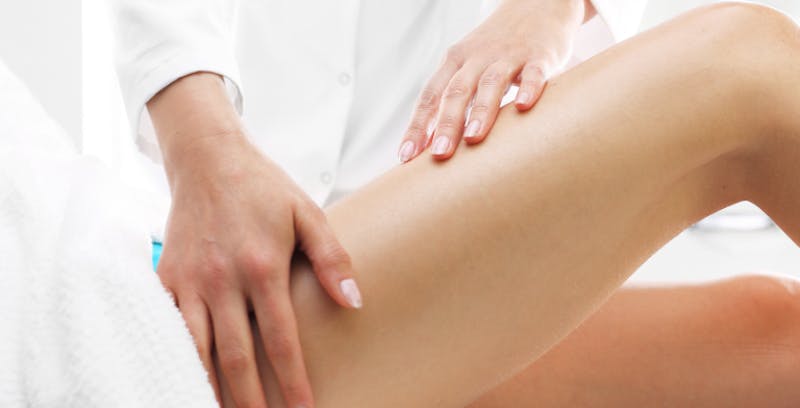
Aging, weight loss, and other factors can cause loose skin to develop on the thighs, a common source of concern. If you’re wary of wearing shorts or swimsuits due to sagging skin on your legs, there are many options to tighten your skin and improve your appearance and self-esteem. However, everyone’s body works differently, so there is no one-size-fits all solution.
For mild cases, loose skin can often be improved with a combination of over-the-counter products and a strict workout regimen that builds leg muscle. However, extreme sagging – often the result of significant weight loss – may require surgical treatment.
Below, we will provide you with an overview of some treatment options to tighten loose skin on the thighs.
What Exercises Tighten Loose Skin On The Thighs?
The answer to this question is a bit complicated. Scientific research on whether exercise can tighten the skin is limited. While some studies indicate that working out may help improve the skin, possibly reducing sagging, they are limited and have yet to be replicated. However, building muscle in targeted areas can significantly reduce the appearance of loose skin by filling the skin with larger muscles, even if it does not actually eliminate it.
If you’re insecure about your thighs, try incorporating some common leg exercises into your workout routine such as:
- Squats
- Front lunges
- Side lunges
- Ladder step-ups
You can find many guided leg workouts online through sites such as YouTube or look into classes at your local gym. Within a few weeks, you may find any sagging or cellulite near your thighs is much less noticeable as you begin to develop muscle and possibly lose fat.
In addition to amping up your exercise routine, making additional changes to your lifestyle can help. Quitting smoking, drinking alcohol in moderation, and wearing sunscreen can all protect your skin from damage, preventing existing sagging from getting worse.
Over-The-Counter Products
For mild sagging skin, over-the-counter firming creams can often help tighten and smooth out skin. However, not all products are created equal. Make sure to read reviews carefully and – when possible – consult a professional for a recommendation, especially if you have existing skin issues and need to take caution when trying new products.
As a very general rule, there are two ingredients to look for in over-the-counter skin firming creams: retinoids and hyaluronic acid.
Retinoids are chemical derivatives of vitamin A that can help with the maturation and turnover of skin cells. This helps skin maintain a youthful appearance, possibly reversing and improving sagging skin. This is more likely to help with crepey skin which is not exactly the same thing.
Hyaluronic acid is a naturally-occuring substance that helps the skin attract and hold water molecules. An ingredient in many age-reversing dermal fillers, hyaluronic acid can help reduce wrinkles and increase skin firmness.
However, not every product works for every patient, especially in the case of severe wrinkling. If exercise and over-the-counter products fail to produce the desired results, you may want to consider non-invasive therapies or even surgery.
Non-Invasive Therapies
There are many different devices on the market today that can help tighten skin to varying degrees. The majority of the most effective devices use radio frequency as the type of energy, but deliver it in varying distinct ways. The device that is right for you depends on your budget, the degree of skin laxity, your skin type, and in many cases, which devices your body responds to.
Other forms of energy that have also been used to tighten skin are ultrasound and laser. If you feel that a non-invasive route is what you are looking for, BLUSH Beverly Hills can likely meet your needs. In many cases, non-invasive therapies simply aren’t strong enough to give the amount of tightening you may desire. In these cases, a surgical procedure is likely most appropriate.
Surgical Treatment
Surgical treatment is frequently necessary for very severe sagging skin that often results from extreme weight loss. Similar to a tummy tuck, a thigh lift can remove loose, sagging skin to leave the legs looking firmer overall.
A thigh lift is performed under general anesthesia. In most cases, your surgeon makes one of two types of incisions depending on your needs. To improve the inner thigh, your surgeon will typically make an incision that starts in the groin and wraps around the back of the thigh. To improve the outer thigh, your incision will also start at the groin, but will extend around the hip before wrapping across the back of the thigh. (However, sometimes you can get by with a small incision near the groin for mild changes.) There are also many variations on these techniques depending on your personal needs.
Once the incision is made, your surgeon lifts the tissue and removes the excess skin and fat. They then close the incisions with sutures and skin adhesives, or tapes.
Bandages and sometimes surgical drains will be put in place during surgery, which you will have to empty and care for at home. Recovery times vary, so speak with your surgeon about your timeline and follow all aftercare instructions closely. Most patients need seven to 10 days of downtime and the majority of patients can resume regular activities within two weeks. Bruising and swelling usually persist longer, however, so you will not see the full effects of a thigh lift for a few months.
In many cases, exercise and over-the-counter creams can have a significant effect on reducing the appearance of loose, sagging skin on the thighs. However, in severe cases, a thigh lift is often necessary to achieve your desired results.
Ready to get started? Leif Rogers, MD is an Ivy League-educated, board-certified plastic surgeon and a standing member of the American Society of Plastic Surgeons. If you’re considering a thigh lift, get in touch with his team to schedule a consultation.

